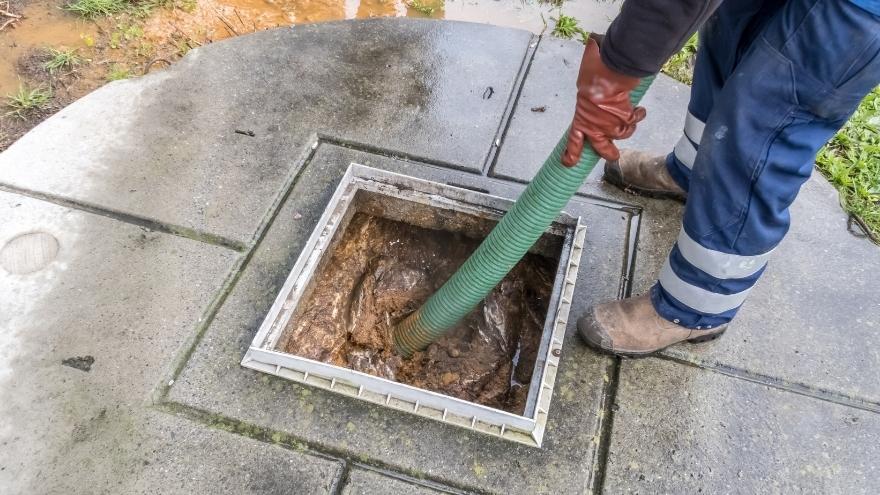Ecological sewage treatment plants are undoubtedly very popular. Such systems with a septic tank and seepage drainage should be arranged in a given area. It must be remembered that, in principle, keeping a septic tank clean is not difficult. Today we will tell you how to do it and what drains to use in an ecological septic tank.

Check out the biological treatment plants at the Onninen wholesaler
How should you clean your home sewage system?
An ecological septic tank is a very practical solution. Importantly, it is particularly useful in the case of households or summer cottages. Properly secured, it prevents the settling tank from breaking out, and the entire work will be really effective. Of great importance is also the fact that an ecological septic tank is tight and resistant to changing temperatures or mechanical damage. In order for the work to be reliable, it is worth using appropriate solutions.
 Concentrated hydrogen peroxide, which is a strong oxidant and removes biological film, will definitely work great. If the drainage is a bit clogged, this preparation will work best. Cleaning should start by removing impurities from the septic tank. This is where not only dirt but also fats accumulate. You can also use a specialist pump that will remove sediment. You cannot forget to check the condition of the filters and nozzles, which prevents them from clogging.
Concentrated hydrogen peroxide, which is a strong oxidant and removes biological film, will definitely work great. If the drainage is a bit clogged, this preparation will work best. Cleaning should start by removing impurities from the septic tank. This is where not only dirt but also fats accumulate. You can also use a specialist pump that will remove sediment. You cannot forget to check the condition of the filters and nozzles, which prevents them from clogging.
If the treatment plant has biological deposits, you need to check their condition. If there is an unpleasant smell, it is also worth using a properly selected agent, i.e. concentrated hydrogen peroxide. Regular cleaning is also crucial and prevents the sewage system from getting clogged. If there is a problem with drainage, then drains are used. You need to know that the drain system drains excess already purified water from the treatment plant tank. At the same time, there is no need to use sewage services frequently. In addition, organic sewage can be discharged into the ground.
What to remember when cleaning an ecological septic tank?
Biological treatment plants require an appropriate design. You also need to choose the right components. For example, you can decide on a telescopic superstructure with a seal. Biological treatment plants with activated sludge in a reactor also work great. As you know, when investing in a treatment plant, you need to match its size to the needs of the household.
 For example, a capacity of 1.35 m3 per day will work well for up to six users. In order for the whole thing to work effectively, domestic sewage treatment plants must be cleaned regularly. The sludge from the septic tank should be removed at least every 2 or 3 years. However, the tank cannot be completely emptied. It is good if 30% of the contents remain in the chamber. As a result, this solution prevents overflow. Cleaning the filters of the treatment plant is another important aspect that allows for better operation.
For example, a capacity of 1.35 m3 per day will work well for up to six users. In order for the whole thing to work effectively, domestic sewage treatment plants must be cleaned regularly. The sludge from the septic tank should be removed at least every 2 or 3 years. However, the tank cannot be completely emptied. It is good if 30% of the contents remain in the chamber. As a result, this solution prevents overflow. Cleaning the filters of the treatment plant is another important aspect that allows for better operation.
To restore full permeability. It is best to do this every three to six months. If an unpleasant smell and sewage accumulates, the cause of this state of affairs is sewage accumulated in the drain, which causes its clogging. You cannot forget about the inspection of the air blower. It is also important to regulate oxygenation and, of course, supplement the cultures of microorganisms. If the drainage that drains sewage becomes clogged or clogged, it is necessary to repair the treatment plant.
Proper selection of means for cleaning the drain in an ecological septic tank
 Drain cleaning requires the use of appropriate agents. Various preparations for start-up, preparations for the decomposition of scum, as well as enzymes, bacteria and nutrients work well. Biopreparations consisting of bacteria inoculated on organic nutrients can be used. Such a product eliminates fats, which are delivered together with sewage to the infiltration system. It also allows you to get rid of unpleasant odors and prevents scale formation.
Drain cleaning requires the use of appropriate agents. Various preparations for start-up, preparations for the decomposition of scum, as well as enzymes, bacteria and nutrients work well. Biopreparations consisting of bacteria inoculated on organic nutrients can be used. Such a product eliminates fats, which are delivered together with sewage to the infiltration system. It also allows you to get rid of unpleasant odors and prevents scale formation.
Of course, you can also opt for blocking drainage in the form of granules, which is a concentrated solution. It contains biological components that serve to break down organic blockages. In addition, the composition includes a complex of enzymes with a high concentration of lipase, which is responsible for the breakdown of fats. Microorganisms complement the microflora in the layer that receives purified sewage. It is best to use such preparations during periodic cleaning of the settling tank, at least once a year.
Check out the biological treatment plants at the Onninen wholesaler